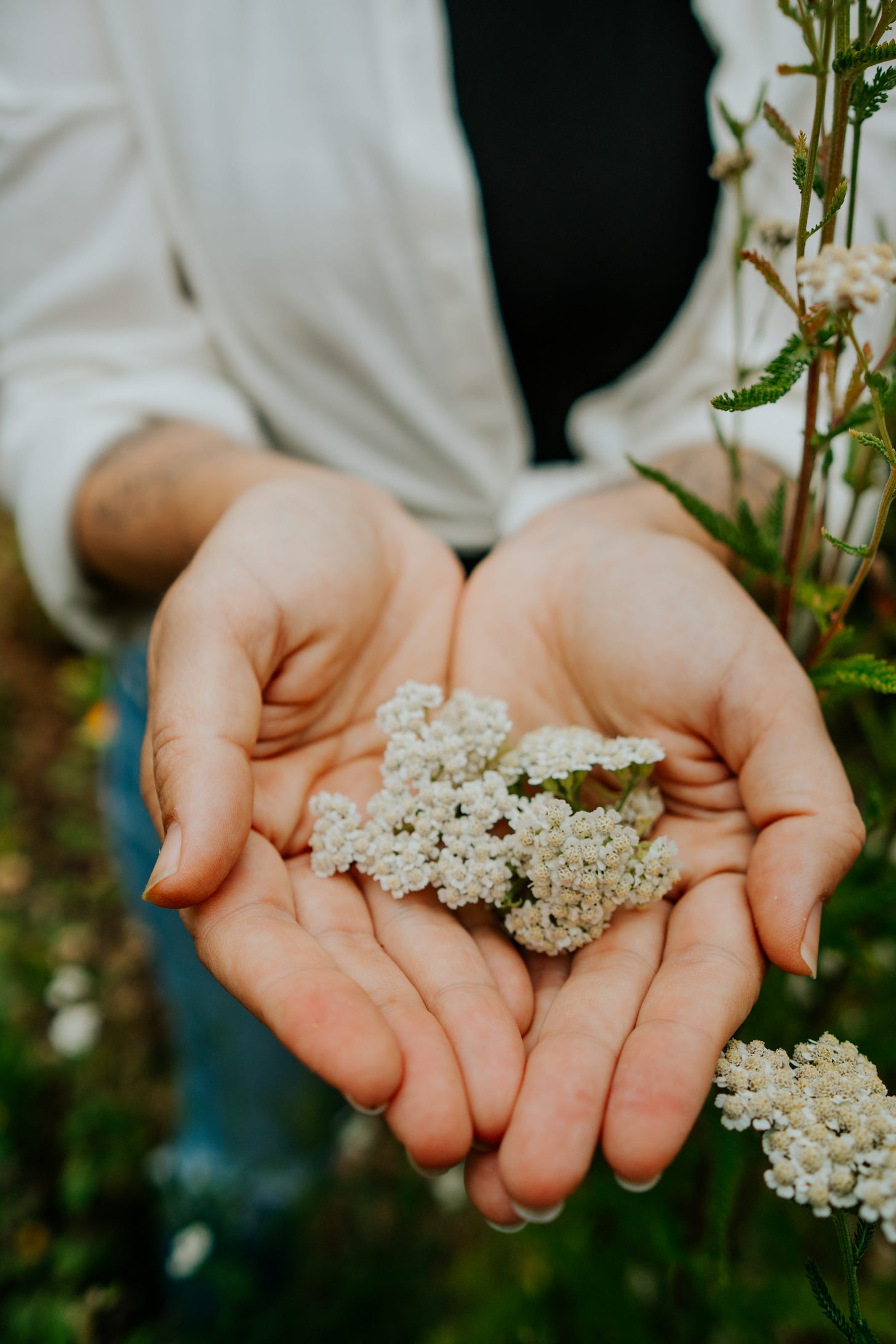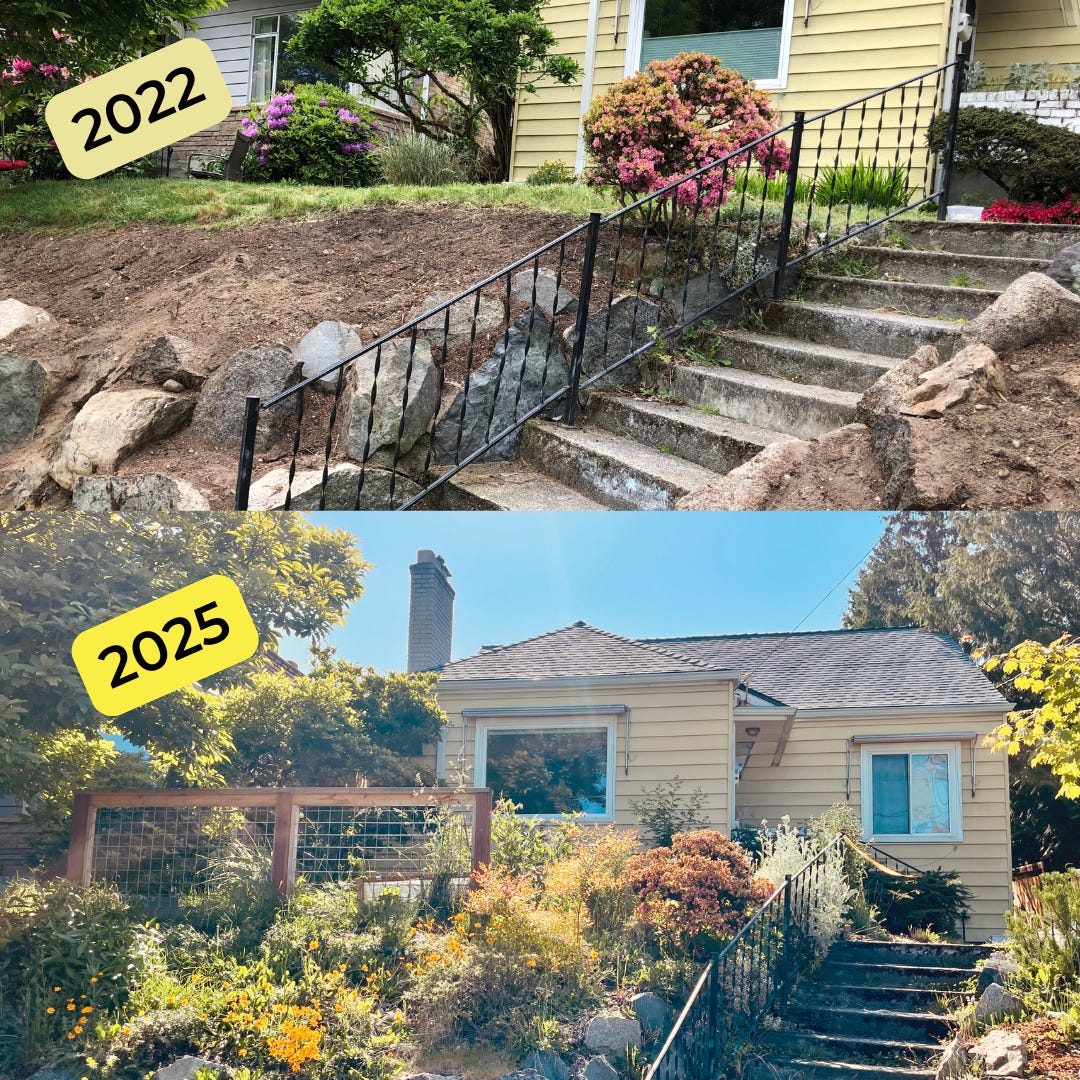Trying something new this week — A VOICEOVER! Let’s see how it goes.
This is part of the Rooted Resilience series— a multi-part exploration on what it means to build real, inner resilience during difficult times. This week we are looking at nature. Dispelling the myth that nature is out there, instead of what it really is — all around us. At any given time we can build a relationship with nature, and in so doing we can get beyond the mindsets that make us feel fragile.
People often assume you need acres of land or a remote mountain retreat to truly connect with nature—as if nature’s current only exists in the wildest places, not right beneath your feet. But connection doesn’t rely on scale. You could have a pot on a patio and still build a meaningful relationship with the plant(s) you tend. What matters isn’t size, but your presence.

For years I had postponed creating the garden I dreamed of because I thought it required owning an acre of land. But in 2023, I stopped waiting. I took my postage-stamp sized yard and converted it into a medicinal plant garden. I realized now is the time. It’s not an acre, but it’s what I have and what I have is enough. So the little patch of lawn in front of my house became something more.
Since then, I’ve grown more than 25 species of medicinal plants—and to my surprise, others I never planted have appeared on their own. Plants know ;-). Birds, butterflies, and at least ten kinds of bees now frequent this pocket-sized sanctuary, too.
What I’ve gained isn’t just a garden, but a daily practice. Each morning I step outside to tend this space, and in that rhythm, I am more deeply rooted. Not just to the land, but in my own body. These plants have become my allies — they steady me against the ups and downs. They teach me what it means to flourish. And could care less how big my yard is – they bloom just the same.
Resilience is built in small ways.
Rooted resilience isn’t about grand gestures. It’s about the small, daily ways we can resource ourselves to face the world.
Modern rhythms admonish the slow and steady, in service of productivity at all costs. But with 51% of U.S. workers reporting burnout in 2024, it’s clear something is off. The pace of our lives is unsustainable—and not only unsustainable, but numbing. Numbing us to our own wholeness, the full spectrum of our expression. We put on blinders to survive the day and lose ourselves along the way.
When our vision narrows like this, it’s easy to believe there isn’t enough—enough time, enough energy, enough of us. That’s the lie of scarcity. I’ve said before and will keep saying it: the heartbeat of nature is abundance. Yet most of us move through the world blindfolded by scarcity. It’s all we can see—and it simply isn’t true.
The garden offers a way back, an access point beyond those constraints. An opportunity to see the world in a different way. Regardless of it’s scale (a pot or a plot), the invitation is always the same: to witness life unfolding. A life unhurried by meetings, deadlines or bosses.
Just life.
As it is.
It’s true. Science says so.
My gardening practice has enriched my life this past year in ways I couldn’t have predicted. When the world feels overwhelming this is where I turn.
Had a tough call? The news is shit? Garbage truck blocking traffic during your commute? Pulling weeds is good medicine.
And it’s not just me saying these things. There have been studies that show gardening:
Lowers cortisol levels (the stress hormone)
Improves mood and reduce symptoms of depression
Supports nervous system regulation through repetitive, mindful actions like watering or weeding!
What the research confirms, I’ve felt in my own body: the daily gestures of connection I feel when I harvest a plant I’ve grown, or the sheer joy of when a hummingbird visits. Each moment tethers me to something outside of my overactive brain. What we give to the earth, she reciprocates tenfold through reminders of how worthy we are to be here.
This is one part of the foundational work I teach via Slow Fox Wellness—helping people walk in tune with nature, to see their spaces as living sanctuaries, and to remember when we tend the land, it tends us back.
Even when things don’t go as planned, unexpected beauty is still possible.
Of all the things the land can teach us about resilience, it’s how to remain steadfast when things don’t go as expected. And in a world where things seem to be going off the rails… this is a useful reminder.
I’ve had perfectly healthy, well positioned plants die for no discernible reason. I’ve also had plants that barely grew one season, take over the garden the next. As much as I may want to claim some kind of supremacy born from my gardening know-how, most of it comes down trust. Loosening my grip enough to let nature’s intelligence do it’s thing.
In her invisible rhythms there is wisdom. Fallow ground is dormant, not dead. And the old becomes compost for the new. Nothing is wasted. Essentially, even when we cannot see what comes next, hope is never lost.
If we can trust the season of time, like we do the cycles of our gardens, then we can always find our way back to center.
……
If you’re curious about cultivating your own wellness garden, I share practices at Slow Fox Wellness to help you create spaces that steady and restore. Here are my Five Pillars of Wellness Gardens: Design Principles for Mind, Body and Spirit to get started.
Share this post.
Support doesn’t just mean money. It is also about helping this work reach more people. This is how it all comes together.



